January 11, 2018 – Volume 20, Issue 1
In This Issue
Flanigan’s Eco-Logic
Chipping Away at My Footprint
Overview of the EV Market
Global EV Market Leaders
EVs in a Down Domestic Market
Overcoming Range Anxiety
Charging Options
Affordable Economics

Flanigan’s Eco-Logic: To Catch a Thief
Here’s a very Happy New Year to you and yours. May 2018 be a terrific year for all… especially for those dedicating their careers to greening the planet! Our mission is obviously all the more important.
You probably had a similar experience this Christmas. Online shopping is having a dramatic impact. I never even considered going to a mall or shopping center this year. Terry arranged for all the kids to give us wish lists complete with links. Everyone got exactly that they wanted… size, color, make.
Online shopping is tremendously efficient. What an evolution. The kids can’t fathom the inefficiency of me shopping for them, and getting it all wrong! So I’ve let go of romantic and outdated gift-giving notions of surprise and meaning. Amazon boasted that it shipped a billion packages.
‘Twas the season and the worst of online shopping. Just before Christmas, I happened to come home early to work at my home office. Our dog, Taxi, periodically on alert, seemed to be going unusually crazy… full-on shrieking to get my attention. It worked. I walked quickly to the front door and through a window was shocked to see a man in our yard walking away with package in hand… a package that I had noticed on our front stoop when I came home.
Was this really happening to us? I’d seen stories about package thieves on the news, a growing problem in this day of online shopping. Thieves simply follow FedEx and UPS trucks taking note of their deliveries. Then they take bold action…
When I realized what was going on, I bolted, threw open the door, and raced after the man, yelling profanities and threats at the top of my lungs. Taxi was livid… and soon Terry was also trailing our angry procession. The thief – white, 30 years old, shaved head… was in escape mode. I got to his car right on his heels, just as he jumped in. If I’d had a rock or hammer, his windshield would have been smashed. A black Dodge Charger… his whip.
In an instant, he slammed his door and floored it… speeding away, tires squealing. Our street was busy, cars backed up. He was nearly boxed in and used the parking lane to escape. He didn’t stop at our nearby intersection, banging a right before we could get his license plate number.
My heart pounding… violation. And as a consolation, there it was, the box he stole, splayed helplessly in the middle of the road where he’d hastily dropped it to get away. Cars were stopped in both directions. They’d witnessed my tirade. They watched as I recovered the box from the street. We filed a police report. Time for cameras.
Fact of the Week
If a passenger car is sold in Norway, it is more likely than not to be electric. Currently, 52% of all auto sales in Norway are electric and the nation plans on boosting this to 100% by 2025.
Chipping Away at My Footprint
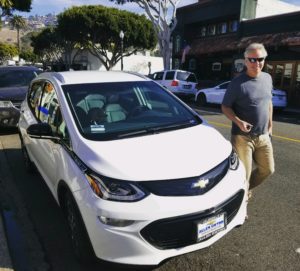 It’s time… Yes, time for new wheels, specifically time for new wheels that emit less greenhouse gas emissions. In the past ten years, I’ve increased my motorized transportation efficiency from 40 MPG (Honda Civic hybrid), to 50 MPG (Prius), and now 119 MPG! The Prius that I shamelessly advocate as the true people’s car of the 21st century, is now near obsolete, replaced with an all-electric Chevy Bolt.
It’s time… Yes, time for new wheels, specifically time for new wheels that emit less greenhouse gas emissions. In the past ten years, I’ve increased my motorized transportation efficiency from 40 MPG (Honda Civic hybrid), to 50 MPG (Prius), and now 119 MPG! The Prius that I shamelessly advocate as the true people’s car of the 21st century, is now near obsolete, replaced with an all-electric Chevy Bolt.Overview of the EV Market

Tesla Roadster
Just a few years ago, one could count the number of electric vehicles available for purchase on one hand. My first EV experience was driving GM EV-1’s in 1998 for LADWP. Then the Tesla Roadster got the ball rolling in 2008. By December 2016, there were 30 “highway legal” plug-in cars in the American market made by more than a dozen car manufacturers. Today there are about 40 EVs available from more than a dozen different brands, and the number is growing.
There are a range of sizes, styles, price points, and powertrains to suit a variety of different needs. Manufacturers range from Tesla and Chevy to Audi, BMW, Cadillac, Chrysler (which offers a minivan), Fiat, Honda, Hyundai, Kia, Mercedes, MiniCooper, Porsche, Smart, Toyota, Volkswagen, and Volvo. The Honda Clarity comes in both plug-in and fuel cell versions.

Jag I PACE
Most broadly defined, EVs come in all sorts of configurations. There are two-wheelers. There are plug-in hybrids, pure electric, and EVs with both electric and gasoline propulsion systems where the front wheels are electric and the rear wheels are gasoline powered (BMW i8). The Cadillac CT6 is like a Volt luxury car. Electric buses are booming, and recently Tesla introduced its semi tractor-trailer with a 500-mile range.
And here’s what’s in store for 2018 in the American market: The long-awaited Tesla Model 3 is now rolling off the assembly lines. There’s a new version of the Leaf, Jaguar is launching the I-PACE, and there’s word of an all-electric Audi Quattro. Furthermore, Faraday Future and Lucid Motors plan to launch their first production EVs in 2018.
Global EV Market Leaders
EVs are not just a U.S. phenomenon. In terms of EV penetration, Norway it is the world leader. There, 52% of all cars now sold are electric thanks to great uptake in Tesla Model S and Model X. Norway has a national goal of fielding only electric vehicles by 2025. With 29% market share, Norway has consistently achieved the most successful deployment of EVs… followed by the Netherlands (6.4% market share), and Sweden (3.4%). China, France, and the United Kingdom have EV sales penetrations of about 1.5%.
In terms of numbers of vehicles sold, through 2015 the United States held the largest portion of the EV stock worldwide. Then China took the lead position in 2016. It’s also the leader in other EV types such as two-wheelers, low speed EVs, and Ebuses with 300,000 on the roads. In 2016, China was the dominant EV market with 40% of all EV sales globally, more than double the amount sold in the United States.
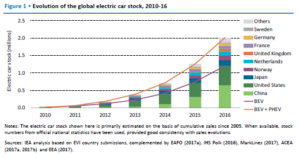
Electric Car Stock (millions) Based on IEA data from Global EV Outlook 2017 © OECD/IEA, www.iea.org/statistics, Licence: www.iea.org/t&c; as modified by Ted Flanigan
The Chevy Volt had been the all-time, the top selling plug-in EV in the United States. Its sales passed 100,000 in July 2016; the most recent data suggests that 113,489 Volts had been sold, followed by 103,597 Leafs. Tesla was number three with 92,317 sold. By the first half of 2017, however, Tesla became the number one EV manufacturer in America. To support these sales, and to accommodate the market leaders, as of January 2016, there were 12,203 charging stations in the U.S. California has 2,976 of these, more than any other state.
EVs in a Down Domestic Market
The rise of electric vehicles in the United States is in stark contrast to overall market conditions. U.S. car sales dropped in 2017, ending a seven-year growth trend fueled in large part by post-recession pent-up demand. Industry analysts suggest that the “auto industries’ long-running sales party has come to an end,” with annual sales anticipated to drop to 17.2 million cars and light trucks sold. Sales experienced a 1.8% decline in 2017 even after discounts and incentives that equaled fully 11.5% of the average sticker price, up from 7% a few years ago.

Source: wardsauto.com/data-center modified by Ted Flanigan
And further decline is expected. Car and light truck sales are anticipated to continue to slide to 16.8 million units in 2018. Several factors caused the drop in sales in 2017: The pent-up demand has now been fulfilled. Exceptionally low interest rates are moving higher. And the market is now pretty saturated; there are 1.26 cars for every registered driver nationally.
While domestic sales are off, global light vehicle sales rose 1.5% in 2017 to 93.5 million cars and trucks. According to the Global EV Outlook, by mid 2016, annual EV sales globally hit 750,000 units. That’s less than 1% of the stock. The global portfolio crossed 1 million units in 2015, and then eclipsed 2 million a year later in 2016.
Overcoming Range Anxiety
Many of my friends have purchased EVs already. Amory drives a BMW i3, as does Jonathan. The first version i3 got 96 miles per full charge, with another 25 or so with its “range extender” in the form of a small gas tank and generator that boosts the total to ~125 miles. The newer versions have a base mileage of 121 miles; 180 with range extender. Range is always the limiting factor for EVs.
Other friends including Gary and Kirstin have Fiat all-electric cars. These may be the most affordable EVs on the market, leased at just $129 per month, but with a very limited range of 84 miles. Reid had a Leaf; he’s now graduated to a Tesla that costs him about a grand a month. Nancy has a Tesla Model X that she loves. Jeanette and Rick are showing off their Tesla Model 3 on Facebook. Matt drives an E-Golf. Stuart has a Spark. I’m catching up with these frontrunners!
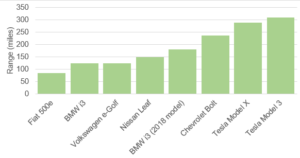
The Bolt’s range is 238 miles per full charge… more if driven conservatively. As a new EV driver, I wondered what this limitation might be like. Should I avoid listening to music? My first trip took me relatively far afield from home in Glendale, to Laguna Beach. A gorgeous, sunny day, and a deep desire to get to the beach, I admit to a slight case of range anxiety all day … until I got home with 150 miles of range left! And yes, the dashboard features a big green bar that shows how much “juice is still left in the tank.”
During my first trip, the Bolt was delivering mobility at a rate of 3.9 miles per kWh. That’s cruising at about 75 mph. Slowing down since then, and using the car for commuting and low-speed, intercity action, I’m now getting 4.3 miles per kWh. And now my instrument panel rewards me… suggesting that I can go 325 miles on a full charge… the power of the operator!
Charging Options
Certainly, charging is one of EVs’ fundamental challenges. It takes time… much more time to charge than to pump. The Bolt provides for all three charging options: it comes with a Level 1 charger that draws 110-volt power from a normal household socket. Nothing fancy. To fully charge the Bolt’s 60 kWh, 288-cell battery pack, it takes 60 hours. (That is not a typo.) This is the charger that I’ve been using exclusively since I got the Bolt. Every day I come home and plug in and replenish the battery pack. My normal commute 14-mile commute requires 3.2 kWh.
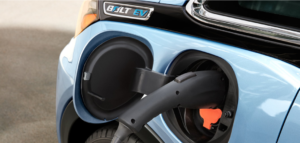 The Bolt’s basic charging is Level 1, done at home using 120 volts at a rate of 4 miles per hour of charge. Chevy recommends charging every day, topping off… as easy as charging your cell phone. To cover my commute, I need only 3 – 4 hours of charge time.
The Bolt’s basic charging is Level 1, done at home using 120 volts at a rate of 4 miles per hour of charge. Chevy recommends charging every day, topping off… as easy as charging your cell phone. To cover my commute, I need only 3 – 4 hours of charge time.
The Bolt also accommodates fast charging, Level 2, at home and public stations. Level 2 is done with 240 volts and provides 25 miles of charge per hour charging, six times the rate of a Level 1 charger. With this form of charging, one can charge every few days. I’m about to install a Level 2 charger at home that charges with 220 volts.
Then there is super fast – SAE Combo DC Fast Charging. This is done at public stations only at a charge rate of 90 miles in 30 minutes. Chevy says this level is about “charging on the go.” My “premium” Bolt is equipped with a Level 3 fast charging port.
Affordable Economics
This morning I passed a gas station and thought to myself, “no need for that real estate anymore.” Will I miss that drill, the smell of fresh gas? Will I lament filling a tank? How will I clean my windshield? Perhaps at times I will miss the gas station pit stops but not so far… I feel liberated in this way. And not to worry, for the foreseeable future I’ll use internal combustion for longer trips.
Like so many eco-freaks, I want a Tesla, super cool and revolutionary. But the Model S is expensive, the Model X is too, and the Model 3 is badly back-ordered. These are not just cool cars, but they’re status symbols… quality signs of success. And at their prices, they are not going to save the world.
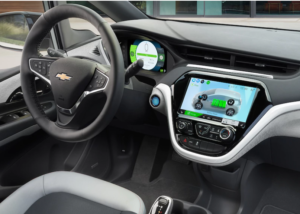
bolt interior
The Bolt, on the other hand, is relatively cheap. You can get the basic model for $38,000. I wanted the premium package – including Level 3 charging capability – which cost ~$43,000. I chose to lease it for three years and the lease fee includes all maintenance throughout the lease term.
Generally I like to buy cars, but where emerging technologies are involved, just like the advanced energy storage systems that EcoMotion now specs out, I recommend leases. While not as attractive in terms of life-cycle economics, there will be advances in this technology no doubt. This is the Bolt’s first year of production. I loathe to be saddled long-term with technologies that new.
My goal was to put down $5,000 and to pay a $200 monthly lease fee. To beat that, I put down $6,500 and signed a contract for a monthly lease fee of $200. Then things get more appealing. Turns out that I will get a $2,500 rebate from State of California, Chevy also has a co-marketing deal with Costco. As a Costco member I get a $600 Costco gift card. So at the end of the day, my net down payment was only $3,400. And given my surplus solar power, my fuel will be effectively free for three years. My normal use of fuel, for a 50 PMG Prius is 12,000 miles/50 miles per gallon = 600 gallons. At $3.00 per gallon, that’s an annual fuel savings of $1,800; a three year savings of $5,400. Hmm, getting into negative net marginal cost territory!
And the news does get better: Chevy sells Level 2 chargers at a discounted cost of $600. My local utility, Glendale Water and Power, offers a $500 rebate, leaving me with a net cost $100 for the actual charger. Then I do have to pay an electrician $200 – 300 to install the charger. But I am still well below my $5,000 threshold.
It’s hard to imagine that Chevy is making money on my lease. How much will my Bolt’s residual be at the end of my lease term? Yes, the lessor gets the full $10,000 tax credit for the Bolt. An unnamed source told Bloomberg News that GM is purposefully taking an $8,000 – 9,000 loss on each Bolt sold… a strategic loss leader to establish dominant market share moving forward. The Bolt is the affordable EV with the good range – perhaps one of the best dollar per mile range values!
And by the way, the Bolt gets 119 miles per gallon equivalent. This is based on the number of miles an EV can travel using the same energy content as gasoline. The MPGe metric was introduced in 2010 by the EPA. EPA used an established industry energy standard of 115,000 BTUs per gallon of gasoline, and the 3,412 BTU per kWh benchmark heat rate, to develop and publish the equivalent ratings.
